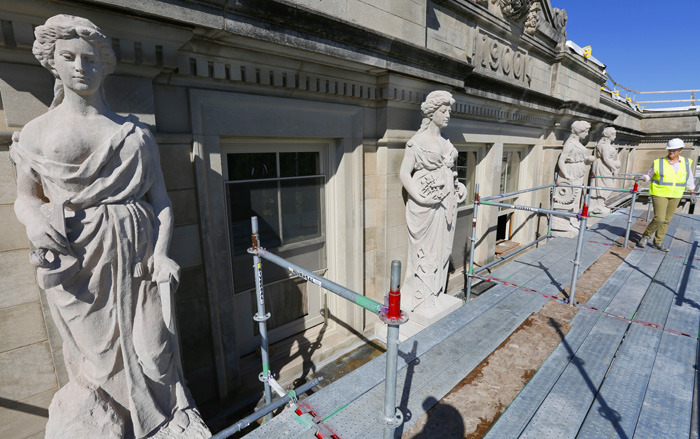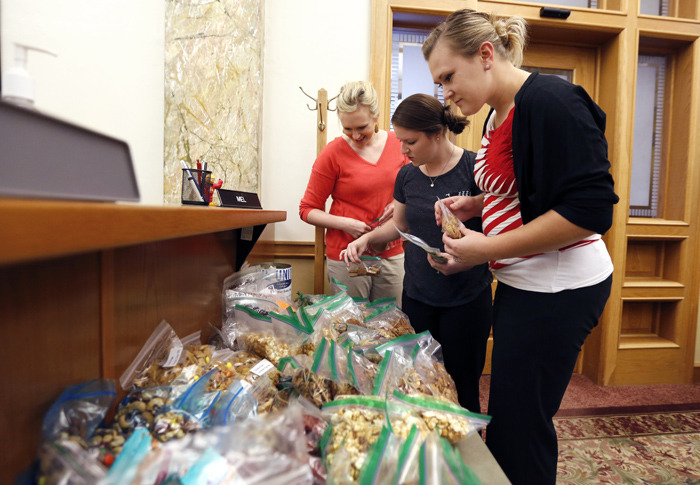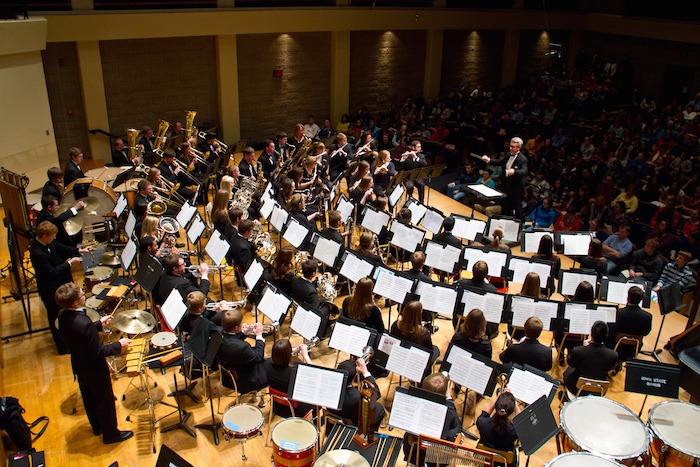Musing, once again

Photo by Christopher Gannon.
The Marston Muses stood fully restored near the top of Marston Hall on Tuesday. Connecticut-based art conservator Francis Miller has been working intermittently on the project since early August, cleaning, repairing and sealing the four limestone sculptures. Kerry Dixon (pictured, right), facilities planning and management's project manager on the Marston Hall restoration, said dismantling of the scaffolding erected for Miller on the east face of the building will start on Oct. 1.
Discussion on racism, diversity draws a crowd
Iowa State students relayed personal stories of racism and microagressions on campus and made suggestions on improving the climate in a well-attended panel discussion Wednesday night.
An estimated 600 university community members packed the Memorial Union Great Hall for a “Discussion on Racism, Diversity and Inclusion.” Joining the discussion were members of the ISU group Students Against Bigotry, President Steven Leath, senior vice president for students affairs Tom Hill and dean of students Pamela Anthony.
The forum stemmed from a Sept. 12 incident in the Jack Trice Stadium tailgate area, where ISU students were protesting comments by presidential candidate Donald Trump on undocumented immigrants. In addition to a sign-ripping incident, student protesters said they were pelted with caps, cans and derogatory remarks.
In opening remarks at the forum, Leath said, “I do believe, by and large, we have a good community and safe campus. But it’s clear now that some people on this campus do not feel safe, at least not all the time. That is deeply concerning.
“If there’s any positive that can come out of this thing that happened a couple weeks ago, it’s that maybe this will shine some light on some issues, where all of us can work toward solutions to make this a better place.”
During the forum, a number of students said they had experienced racism and discrimination, ranging from derogatory remarks to what one student described as the frequently asked “infamous" question, “Where are you from?” Some students also said they did not feel safe on campus. Students offered a number of suggestions to improve the university climate. They include:
- Extending ISU’s safety escort service beyond campus
- Requiring administrators and faculty to undergo training on diversity and SafeZones (welcome places for LGBTQ individuals)
- Improving graduation rates and scholarship support for minority students
- Commissioning more campus art by under-represented artists
Leath and Hill promised to study the recommendations.
Leath noted that he also has a list of recommendations from a diversity study he commissioned a couple of years ago. One of the top recommendations was that Iowa State hire a chief diversity officer. The search for that officer, specifically a vice president for diversity and inclusion, is currently underway.
“We have interviewed four exceptional candidates, all well qualified for the job and we’ll be making a decision possibly as early as this week,” Leath said.
He added the new VP will tackle additional recommendations in the diversity report.
Grant will fund UIA study of advising for low-income, first-generation students
The University Innovation Alliance, of which Iowa State is a founding member, has been awarded $8.9 million to evaluate the effectiveness of academic advising in increasing retention, progression and graduation rates for low-income and first-generation students.
The U.S. Department of Education selected Georgia State University (on behalf of the UIA) for the grant through its First in the World competition, which encourages innovation among institutions of higher education. The grant will fund a four-year study of 10,000 students on UIA's 11 member campuses, who are exposed to an intensive menu of advising services. Through quantitative and qualitative research and analysis, the study will examine the benefits of introducing systematic, proactive advising, especially for at-risk students.
Students will be selected by random assignment and will receive, in addition to advising services typically offered:
- Intensive, proactive advisement to help them establish individualized academic maps
- Real-time alerts prompted by a system of analytics-based tracking when they may be struggling
- Timely, targeted advising interventions to get them back on the appropriate academic path
The project is called MAAPS, or Monitoring Advising Analytics to Promote Success. If the project is successful in improving student outcomes, the long-term goal will be to scale the advising interventions for all of the more than 380,000 students enrolled in UIA institutions.
Iowa State's portion of the grant is $710,000. The funds will be used to increase the university's advising capacity to accomplish the project goals. University Professor Steve Freeman, faculty adviser to ISU President Steven Leath, says two new, full-time advising positions will be secured, as well as a half-time data analyst to assist in documenting project outcomes.
UIA was formed in September 2014 when 11 public research universities joined together to expand the use of highly successful, innovative programs designed to help more students complete a college education.
In addition to Iowa State, the UIA includes:
- Arizona State University
- Ohio State University
- Georgia State University
- Michigan State University
- Oregon State University
- Purdue University
- University of California, Riverside
- University of Central Florida
- University of Kansas
- University of Texas at Austin
For more information, visit www.theUIA.org.
Nonsupervisory merit open change period begins Oct. 5
Nonsupervisory merit employees have an opportunity to review and change their benefits during the annual open change period, Oct. 5 (9 a.m.) through Nov. 23 (5 p.m.).
Changes for 2016
As a result of last winter's collective bargaining process, several health insurance changes will go into effect beginning Jan. 1, 2016.
Mark your calendar
- Oct. 5 (9 a.m.): Open change period begins; participation statements available on AccessPlus
- Oct. 14 (9-10:30 a.m.): Live webcast
- Oct. 21 (8:10-8:50 a.m. or 12:10-1 p.m.): Open forum in 1210 LeBaron Hall
- Oct. 21 (10-11:15 a.m. or 3-4:15 p.m.): Open forum in 301A/B Spedding Hall
- Nov. 23 (5 p.m.): Open change period ends
- Dec. 4 (9 a.m.): Benefit confirmation statements available on AccessPlus
- Dec. 11 (5 p.m.): Corrections to benefits statements due at 3810 Beardshear
- Dec. 15 (9 a.m.): Final benefits statements available on AccessPlus
Health insurance plans
Most of the health plans offered in 2015 also will be available in 2016, with the exception of Blue Advantage. Blue Access, Iowa Select and Program 3 Plus will be offered with changes, which are described below.
Employees currently enrolled in Blue Advantage may select from the remaining plans during the open change period. After that time, those who did not indicate a new plan choice will automatically be moved to Blue Access beginning Jan. 1, 2016.
Health insurance premiums
The contribution mix for nonsupervisory merit employees will change in 2016. Employees must contribute $20 per month for single coverage for the Blue Access, Iowa Select and Program 3 Plus plans.
The employee contribution for family coverage will be $20 per month for Blue Access. Family coverage for Iowa Select will be 15 percent of the total premium, and family coverage for Program 3 Plus will be the difference between the total premium and 85 percent of Iowa Select's total premium.
Health insurance plan design changes
The Blue Access plan will require a 10 percent coinsurance for services that do not currently require copays. Examples of these services include inpatient and outpatient hospital care, ambulance service and urgent care. Previously, employees had no out-of-pocket costs for these services. The medical maximum out-of-pocket for Iowa Select and Program 3 Plus will increase to $650 (from $600) for single coverage, and $1,450 (from $800) for family coverage. All deductibles, coinsurance and copays will go toward the out-of-pocket limit for all plans.
Prescription drug benefit
The Iowa Select and Program 3 Plus prescription drug maximum out-of-pocket costs (the most that members will pay in a year) are going up in 2016. Single coverage will increase from $250 to $500, and family coverage will increase from $500 to $1,000. Once employees have reached the out-of-pocket maximum, the health insurance plan will pay 100 percent of the allowed amount for the rest of the calendar year.
Double spouse family contract
If you and your spouse both are employed at Iowa State as eligible, nonsupervisory merit staff, you have the option of sharing a double spouse family insurance contract for $20 per month. The cost will come from the contract holder.
The double spouse option also applies to the family dental plan. If there are no children to insure, two single dental plans for each employee is more cost effective.
Dental enrollment is open
Nonsupervisory merit employees have the option to enroll themselves or add spouses and dependent children to their dental plan this year.
How to make changes to your benefits
Nonsupervisory merit employees may alter their medical, dental, flexible spending and Avesis (eyewear/contacts/Lasik) coverage online through AccessPlus. Enrolling in or increasing employer-sponsored group term basic or voluntary term life insurance will require paper forms. If you aren't making changes to your benefits, you do not need to take any action, though you should review your current benefit elections and information on your dependents and beneficiaries.
More information
UHR is hosting a live, interactive webcast about the 2016 benefits changes for nonsupervisory merit employees on Oct. 14 (9-10:30 a.m.) To participate, log on, enter your name under the "Enter as a Guest" heading, then click "Enter Room." If you are unable to attend the live webcast, a link of the recorded session will be available on UHR's benefits Bulletin Board.
Employees also may attend face-to-face presentations on Oct. 21. The schedule is in the box above.
Privacy, safety are central to new policies
The university community has about six weeks to comment on two new policies in development that focus on privacy and safety issues surrounding drones and video camera use.
Send your feedback
Comments and questions on the policies can be submitted through Nov. 16 by email.
Drones
A proposed amendment to an existing facilities and grounds use policy provides approval procedures for the operation of drones and other unmanned aircraft on ISU property -- indoors and outdoors. Commercial users must request written approval from facilities planning and management, provide proof of insurance and comply with federal regulations. The use of drones at the research and demonstration farms must be approved by the ISU farms director.
Drones used for university purposes, by university employees, must be approved by a central flight operations manager. However, the policy amendment does not apply to research, academic and extension use approved by either the senior vice president and provost or the vice president for research. Those requirements are outlined on the VPR website.
Video cameras
The video camera draft policy offers guidelines for administrative use -- specifically crime prevention, public spaces and customer service. It does not apply to video camera use for academics (research, extension), public events (athletics, music, theater), training programs, journalism (news, marketing) and standard police practices.
The policy guidelines are intended to protect personal privacy and adhere to legal standards. For instance, cameras must not monitor or record conversations without consent. Other proposed policy requirements include:
- 30-day retention limit for recordings
- Camera placement that avoids privacy invasion
- FPM authorization for camera installation and placement
Early giving season

Accounts receivable staff members, from left, Holly Hohanshelt, Amanda Redling and Laura Graves, ponder their choices during a bake sale hosted Wednesday by the office of the senior vice president and provost. The one-day sale was a fundraiser for the United Way of Story County. Other events to benefit the United Way, including several online auctions, continue into early November. Photo by Christopher Gannon.
Partial campus shutdown approved for 11 days during winter break
Iowa State administrators have approved the details of a partial university shutdown this winter during the semester break. The partial closing will run 11 days from Thursday, Dec. 24, through Sunday, Jan. 3, and includes:
- Three university holidays (Dec. 24, 25 and Jan. 1)
- Two weekends (Dec. 26-27 and Jan. 2-3)
- Four regular work days (Dec. 28-31)
The closing is not mandatory on days that are not a weekend or holiday. Employees who choose to participate will be required to take paid or unpaid leave for the four workdays.
"No classes are in session, a number of external organizations will either be closed or operating at reduced levels and many staff members anticipate being on leave," noted senior vice president for business and finance Warren Madden in a memo to administrative officers. The goals, he said, are to accommodate the lighter staffing levels, conserve energy and allow units to achieve budget savings.
All departments, Madden said, should review their plans with the appropriate dean, vice president or senior vice president.
Questions about the partial shutdown may be directed to Kristi Darr, university human resources, 294-3753.
Share your plans
Madden said the intent is that many Iowa State facilities will be closed and locked during the 11 days just like they are on university holidays. Thus, many services will be either unavailable or available for a limited time. Critical services, campus maintenance and research programs that need to operate during this period may do so. Partial staffing may occur to carry out a unit's scheduled activities, research programs or other priorities, he said.
Madden encourages units to develop and share their semester break closing plans as soon as possible so that students, staff members and customers can plan ahead as needed.
Units that close for the 11 days will need to leave emergency contact numbers on websites and voicemail, turn down thermostats, turn off equipment and, if outdoor temperatures drop to sub-zero, designate someone to periodically check work spaces for plumbing, heating or cooling malfunctions. Staff should regularly check voicemail on key phone numbers and respond to callers.
This will be Iowa State's seventh consecutive year for a partial winter shutdown. The first, in 2009, came in response to a state funding reversion.
Flexible hours guidelines
Supervisors considering reduced hours of operation during Thanksgiving week, spring break and semester break days not included in the partial closing period can find useful information in the university's flexible hours program guidelines.
Music makers

ISU Wind Ensemble. Submitted photo.
A diverse musical repertoire will fill Music Hall's Martha-Ellen Tye Recital Hall next week when several ISU student music groups make their fall concert debuts.
ISU Wind Ensemble
The 60-member ISU Wind Ensemble, directed by music professor and chair Michael Golemo, takes the stage Sunday, Oct. 4, at 3 p.m. The group will perform "Star Wars" by John Williams, "Celebration Overture" by Paul Creston and "Winter Dreams" by Michael Daughtery. Admission is $5 ($3 for students).
ISU Jazz Combos
Two groups of 12 students, directed by senior lecturer Michael Giles, will present a variety of small-group, improvisational jazz performances on Tuesday, Oct. 6, at 7:30 p.m. The combos, which typically consist of two horn players and a rhythm section, will celebrate the '80s, playing popular music from the decade as well as other less familiar jazz selections composed during that time. There is no admission fee.
ISU Jazz Ensembles I and II
ISU's Jazz I and Jazz II Ensembles feature up to 21 students each. Jazz I is directed by associate professor James Bovinette, and Jazz II is led by Giles. Both groups will perform Wednesday, Oct. 7, at 7:30 p.m. Jazz I will play a mix of contemporary jazz and standard big band numbers. Jazz II will perform an "as-seen-on-TV" set, showcasing television show themes. Admission is $5 ($3 for students).
